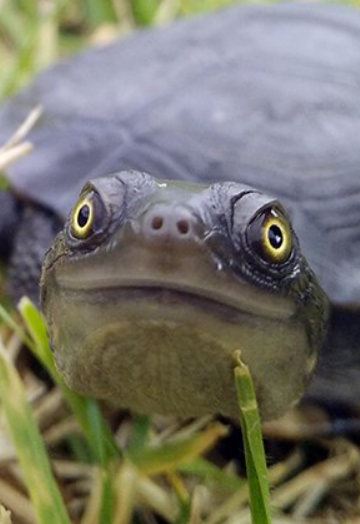Turtles key to river recovery
 Experts say turtles could play a critical role in 'fish kill' clean-ups and the European carp cull.
Experts say turtles could play a critical role in 'fish kill' clean-ups and the European carp cull.
A study of freshwater turtles in the Murray-Darling Basin has found that replenishing their numbers will be critical to the successful cull of European carp and cleaning up after devastating 'fish kills' in rivers.
The Australian Government has been working for several years on plans to use a biocontrol agent to eliminate the introduced carp species from South East Australian waterways.
“The European carp cull – which is referred to as ‘Carpageddon’ – will use a viral biocontrol to rid rivers of this invasive pest, so that it can return to its former ecological state and offer improved habitability for threatened native species,” says Associate Professor Ricky Spencer from Western Sydney University.
“However, unless there is an effective clean-up plan in place, Carpageddon will lead to hundreds of thousands of tons of fish carcasses rotting in our waterways, and will cause further habitat damage.”
Dr Spencer ran a series of experiments in 2018, which simulated the environmental conditions after a major fish kill event.
Carp carcasses were introduced in four outdoor field sites near Murray Bridge, South Australia. The bait was submerged using a range of methods that allowed access to turtles, shrimps, prawns or crayfish.
In addition, researchers set up controlled mesocosm experiments – both with, and without turtles – using a state-of-art experimental wetland facility at Western Sydney University’s Hawkesbury campus.
In both the field and mesocosm experiments, researchers monitored the decomposition of the carp carcasses and recorded any changes to water quality.
Their key findings included;
- Carp that were accessible to turtles perished more rapidly than those not accessible to turtles
- In mesocosms with turtles, carp carcasses were stripped to skeletons within five days, whereas carcasses took more than 27 days to decompose without turtles present
- Turtle scavenging resulted in water chemistry rapidly returning to normal – including rapid decreases in ammonia levels and consistent dissolved oxygen levels – which allowed water conditions (algae/ cyanobacteria and turbidity) to be maintained
The experiment accounted for the role of crayfish, prawns, and shrimp – fellow scavengers in freshwater systems – but found that none were as effective as turtles.
Dr Spencer says the findings clearly demonstrate the importance of the recovery of turtle populations.
“Freshwater turtles once occurred in high numbers in Australian waterways, but are now in sharp decline – in large part due to urbanisation, cars and foxes,” he said.
“There are a number of significant threats to turtles, which could lead them to becoming functionally extinct soon – which means they wouldn’t be able to play their significant role in the ecosystem that helps to regulate water quality.
“Scavengers like turtles are part of our natural capital. They perform a job in the ecosystem that should be valued and quantified. The cost of introducing turtles as a natural clean-up crew should be quantified – just as it would be worked out how much it would cost to remove carp with boats and nets, or to build a filtration plant to clean our drinking water.
“It would probably be cheaper to boost the numbers of turtles in the Murray-Darling, than try and remove every dead fish from wetlands. The beauty of this solution is that you have a community more than willing to volunteer their time to boost baby turtle numbers in the river.
“We’re not just talking about the health of our rivers here, we’re talking about human health. These are river systems that supply our drinking water and irrigate the fruit and vegetables we eat.
“Turtles are critical to sustaining the health of humans, as well as our rivers.”








 Print
Print